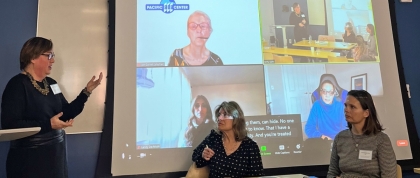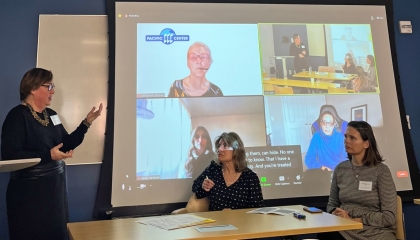
Hosted by the GPH Complex Public Health Disasters Lab
With the passage of the Americans with Disabilities Act (ADA) in 1990, the nation promised people with disabilities the same rights and opportunities as those without, enshrining protections against discrimination and providing a framework for a more inclusive nation. Over thirty years later, with a stronger national focus on diversity, equity, and inclusion, we ask whether the promise of the ADA has been fulfilled and what obstacles may stand in the way.
During a recent NYU GPH symposium titled “How is Disability a Part of DEI?”, people with disabilities, advocates, researchers, and professionals gathered to investigate these questions and shed light on some of the most pervasive barriers to a fully inclusive nation. This event was held through a partnership between NYU’s Complex Public Health Disasters lab and the Center for Anti-racism, Social Justice & Public Health.
Representing the Pacific ADA Center, a program that serves the southwestern United States in understanding and applying the ADA and related disability rights laws, Director Jerri Davison and Deputy Director Jan Garrett began the event by discussing the American history of disability and the ADA. Davison first acknowledged that disability does not exist in a vacuum. “Disability doesn't discriminate. It intersects with all ages, races, religions, genders, sexual orientations, and multi-marginalized individuals tend to experience these barriers at higher levels.”
Davison and Garrett continued by discussing the historical contexts for discrimination in housing, healthcare, education, employment, and community, noting that many lingering issues still exist in each area. “People with physical, intellectual, psychiatric disabilities are still living outside of the community,” explained Garrett. “People should be integrated into the community, and States should be giving a preference for that but there now is a lack of affordable and accessible housing options.”
The event continued with a presentation on current disability-related disparities by Bill Erickson, researcher at the Cornell University Yang-Tan Institute on Employment and Disability. Erickson made the case for stronger data collection on disability, explaining that better statistical knowledge helps policymakers, providers, and advocates to better understand the issues and trends in disability and guide efforts toward full inclusion. Discussing the intersection between race, ethnicity, disability, and inclusion, Erickson shared key national statistics on employment by race and disability, with the greatest disparities being faced by Black Americans with disabilities.
Dr. Robyn Gershon and Owen Slyman, researchers from the NYU Complex Public Health Disasters Lab, then presented findings from their recent study on the barriers ADA Coordinators face in ensuring equity. “The legislation is not immediately accessible to anybody, let alone people with disabilities,” explained Dr. Gershon. “And I think most Americans really, frankly, don't know very much about it." Slyman shared that in the lab’s cross-sectional study of 71 ADA Coordinators in FEMA Region IX, many felt that they did not have the appropriate support and guidance on ensuring inclusion. “What we’re finding is that there are a lot of ADA Coordinators who are feeling disconnected and ineffective,” explained Slyman. “When people do not have a well-defined set of responsibilities, it affects how meaningfully they can uphold these rights.”
The symposium then began a panel discussion featuring Wendy Strobel Gower and Dr. LaWanda Cook of the Northeast ADA Center, Jan Garrett of the Pacific ADA Center, and Laney Davidson, Disability Access Manager and consultant. Asked whether the promise of the ADA had been fulfilled, Davidson responded “There are definitely successes of the Americans with Disabilities Act. It sets the framework that made possible the creation of many Federal and State regulations that change the lives of people with disabilities.” However, Davidson indicated there is still much progress to be made, particularly in the arenas of programs and social services and looking at ableism through an intersectional lens.
Asked about ways to make progress toward full inclusion for people with disabilities, Garrett answered “One is to better educate the public about disability and about disability rights and what is going well, what isn't going well.” Despite the ADA’s passage over 30 years ago, Garrett stated “we end up talking to people every day who don't really know what the ADA says or requires.” Strobel Gower stressed the importance of community-building, stating “People don't change because Cornell or someone at the Pacific ADA Center or some other external institution says I have to. They change because of communities.”
Dr. Cook followed up by discussing shortcomings in accommodations processes, mentioning that these systems put the overwhelming burden on people with disabilities to secure their own rights and opportunities. “We have a structure that suggests if you have the right to speak up for yourself, then everything will be fine, right? But we know that's not true. We know that there are disparities in terms of how different people, when they speak up for themselves, are treated.”
The conference concluded with a Q&A session. Audience members shared their personal experiences accessing accommodations in the academic and workplace settings and asked how the growing role of artificial intelligence in health care may help or hinder efforts toward inclusion for people with disabilities. To hear panelists’ responses and watch the entire symposium, click on the video above.
